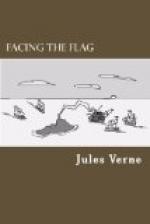It goes without saying that this crypt, given its position and structure, belongs to the category of those which are due to the encroachments of the sea. It is at once of Neptunian and Plutonian origin, like the grottoes of Crozon and Morgate in the bay of Douarnenez in France, of Bonifacio on the Corsican coast, Thorgatten in Norway, the height of which is estimated at over three hundred feet, the catavaults of Greece, the grottoes of Gibraltar in Spain, and Tourana in Cochin China, whose carapace indicates that they are all the product of this dual geological labor.
The islet of Back Cup is in great part formed of calcareous rocks, which slope upwards gently from the lagoon towards the sides and are separated from each other by narrow beaches of fine sand. Thick layers of seaweed that have been swept through the tunnel by the tide and thrown up around the lake have been piled into heaps, some of which are dry and some still wet, but all of which exhale the strong odor of the briny ocean. This, however, is not the only combustible employed by the inhabitants of Back Cup, for I see an enormous store of coal that must have been brought by the schooner and the tug. But it is the incineration of masses of dried seaweed that causes the smoke vomited forth by the crater of the mountain.
Continuing my walk I perceive on the northern side of the lagoon the habitations of this colony of troglodytes—do they not merit the appellation? This part of the cavern, which is known as the Beehive, fully justifies its name, for it is honeycombed by cells excavated in the limestone rock and in which these human bees—or perhaps they should rather be called wasps—reside.
The lay of the cavern to the east is very different. Here hundreds of pillars of all shapes rise to the dome, and form a veritable forest of stone trees through the sinuous avenues of which one can thread one’s way to the extreme limit of the place.
By counting the cells of the Beehive I calculate that Count d’Artigas’ companions number from eighty to one hundred.
As my eye wanders over the place I notice that the Count is standing in front of one of the cells, which is isolated from the others, and talking to Engineer Serko and Captain Spade. After a while they stroll down to the jetty alongside which the tug is lying.
A dozen men have been emptying the merchandise out of the tug and transporting the goods in boats to the other side, where great cellars have been excavated in the rocks and form the storehouses of the band.
The orifice of the tunnel is not visible in the waters of the lagoon, and I remember that when I was brought here I felt the tug sink several feet before it entered. In this respect therefore Back Cup does not resemble either the grottoes of Staffa or Morgate, entrance to which is always open, even at high tide. There may be another passage communicating with the coast, either natural or artificial, and this I shall have to make my business to find out.




